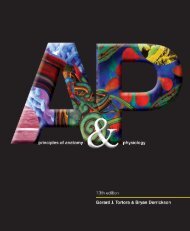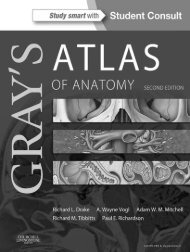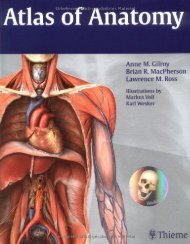theanatomyandphysiologylearningsystem4epdfdr-150930024720-lva1-app6891
Create successful ePaper yourself
Turn your PDF publications into a flip-book with our unique Google optimized e-Paper software.
Chapter 2 Chemistry, Matter, and Life 31<br />
From The Pharmacy—cont’d<br />
States Adopted Names (USAN) council. The brand name is a trade<br />
(proprietary) name that is assigned by the manufacturing company.<br />
The public is most familiar with brand names because that is what is<br />
used in advertising. Generic names are increasingly used in health<br />
care, so the practitioner needs to be conversant with both generic<br />
and brand names for effective communication. Here are some examples<br />
of generic and brand names of commonly used medications.<br />
Generic Name<br />
Brand Name<br />
acetaminophen<br />
Tylenol, Datril<br />
aspirin<br />
Bufferin, Ecotrin<br />
cyclobenzaprine<br />
Flexeril<br />
diazepam<br />
Valium<br />
diltiazem<br />
Cardizem<br />
furosemide<br />
Lasix<br />
ibuprofen<br />
Advil, Motrin<br />
warfarin<br />
Coumadin<br />
Medications may be classified according to the form of preparation<br />
as oral solids, oral liquids, topical, injectable, vaginal, rectal,<br />
ophthalmic, or otic. A few preparations (such as nasal sprays,<br />
inhalants, implants, and insulin pumps) do not fit any of these<br />
groups and are classified as miscellaneous.<br />
Mixtures, Solutions, and Suspensions<br />
Mixtures<br />
A mixture is a combination of two or more substances, in<br />
varying proportions, that can be separated by ordinary physical<br />
means. The substances retain their original properties after<br />
they have been combined in a mixture. The components of a<br />
mixture may be elements (such as iron and sulfur), compounds<br />
(such as sugar and water), or elements and compounds (such<br />
as iodine and alcohol).<br />
Solutions<br />
Solutions are mixtures in which the component particles<br />
remain evenly distributed. All solutions consist of two parts:<br />
the solute and the solvent. The solute is the substance that<br />
is present in the smaller amount and that is being dissolved.<br />
It may be a gas, liquid, or solid. The solvent, usually a gas or<br />
liquid, is the component that is present in the larger amount<br />
and that does the dissolving. In a sugar solution, the sugar<br />
is the solute and the water is the solvent. Water is the most<br />
common solvent and is called the universal solvent. Alcohol<br />
and carbon tetrachloride are also commonly used solvents.<br />
When alcohol is the solvent, the solution is called a tincture.<br />
For example, when iodine dissolves in alcohol, the solution<br />
is called tincture of iodine. The composition of a solution is<br />
variable; that is, it may be weak or concentrated. In a sugar<br />
solution, whether there is a small amount of sugar or a large<br />
amount, it is still a solution. Although a solution is always<br />
clear and the solute does not settle, the components may be<br />
separated by physical means such as evaporation. For example,<br />
when the water evaporates from a sugar and water solution,<br />
rock sugar forms.<br />
Suspensions<br />
Some mixtures involving a liquid settle unless they are continually<br />
shaken. If sand is mixed with water, shaken, and then allowed<br />
to settle, the particles of sand will fall to the bottom. This is a type<br />
of mixture called a suspension. A suspension is cloudy and its<br />
particles settle. Blood cells form a suspension in the plasma.<br />
One type of mixture that is particularly important in the<br />
body is the colloidal suspension. The particles in a colloidal<br />
suspension are so small that they remain suspended in the liquid<br />
but they do not dissolve. Mayonnaise, although not of particular<br />
importance in the body, is a colloidal suspension. In this<br />
case, the vinegar is the suspending medium and the beaten egg<br />
provides the colloidal particles. More relevant, perhaps, is the<br />
fact that the fluid that fills the cells of the body, the cytoplasm,<br />
is a colloidal suspension.<br />
Electrolytes, Acids, Bases, and Buffers<br />
Acids, bases, and salts belong to a large group of compounds<br />
called electrolytes. There are numerous electrolytes in the body,<br />
and their concentrations are an important aspect of health care.<br />
Electrolytes<br />
Electrolytes (ee-LEK-troh-lites) are substances that break up,<br />
or dissociate, in solution to form charged particles, or ions.<br />
These compounds are called electrolytes because the ions can<br />
conduct an electrical current. When an ionic compound such<br />
as sodium chloride, NaCl, is placed in water, the positively<br />
charged sodium ion is attracted to the negatively charged oxygen<br />
end of the water molecule. The negatively charged chloride<br />
ion is attracted to the hydrogens of the water molecule. Because<br />
the polar covalent bonds of the water are stronger than the ionic<br />
bonds of the sodium chloride, the sodium chloride breaks apart,<br />
or dissociates, into cations and anions in the water. Figure 2-13<br />
illustrates the dissociation of sodium chloride in water. Refer to<br />
Table 2-2 for some of the cations and anions in the body.<br />
Quick Applications<br />
The electrocardiogram and electroencephalogram are<br />
graphic tracings of the electrical currents created by<br />
the movement of electrolytes in the heart and brain,<br />
respectively.<br />
Acids<br />
Everyone is familiar with acids of various types. Orange juice,<br />
lemon juice, vinegar, coffee, and aspirin all contain acids. Acids<br />
have a sour taste. An acid is defined as a proton donor. Think<br />
about the structure of a hydrogen atom: it has one proton in the<br />
nucleus and one electron in the electron shell. When the hydrogen<br />
atom loses its one electron and becomes a hydrogen ion, its

















